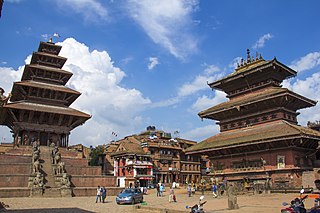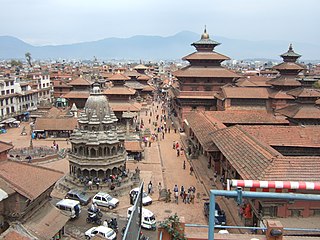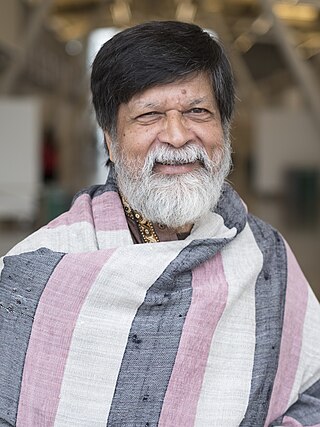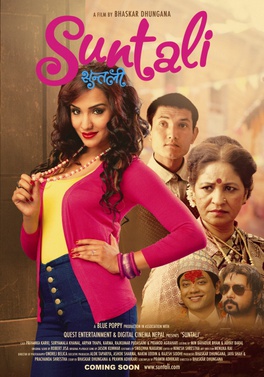Related Research Articles

Kathmandu, officially Kathmandu Metropolitan City, is the capital and most populous city of Nepal with 845,767 inhabitants living in 105,649 households as of the 2021 Nepal census and 2.9 million people in its urban agglomeration. It is located in the Kathmandu Valley, a large valley in the high plateaus in central Nepal, at an altitude of 1,400 metres.

Bhaktapur, known locally as Khwopa and historically called Bhatgaon, is a city in the east corner of the Kathmandu Valley in Nepal located about 13 kilometres (8.1 mi) from the capital city, Kathmandu. Bhaktapur is the smallest city of Nepal as well the most densely populated. Along with Kathmandu and Lalitpur, Bhaktapur is one of the three main cities of the Kathmandu Valley and is a major Newar settlement of the country. The city is also known for its Newar tradition, cuisine and artisans. Bhaktapur suffered heavy damage in the April 2015 earthquake.

Panchayat (Nepali:पंचायत) is a 2017 Nepalese drama social film, directed and written by Shivam Adhikari and produced by Sushanta Shrestha and Sankhar Shrestha, under the banner Kalawati Films with NepalFlix and Hetauda Movies. The film is based on panchayat system in Nepal and it is mainly aimed at women and the film is set in 1974. The film stars Neeta Dhungana in the lead role along with Saroj Khanal, Rupa Rana, Ganesh Giti, Jahanwi Basnet and Bishal Pahari. It was selected as the Nepalese entry for the Best Foreign Language Film at the 91st Academy Awards, but it was not nominated.

Lalitpur Metropolitan City is a Metropolitan city and fourth most populous city of Nepal with 299,843 inhabitants living in 49,044 households per 2021 census. It is located in the south-central part of Kathmandu Valley, a large valley in the high plateaus in central Nepal, at an altitude of 1,400 metres.

Shahidul Alam is a Bangladeshi photojournalist, teacher and social activist. He has been a photographer for more than forty years and "his photographs have been published in almost every major western media outlet".

A dhunge dhara or hiti is a traditional stone drinking fountain found in Nepal. It is an intricately carved stone waterway through which water flows uninterrupted from underground sources. Dhunge dharas are part of a comprehensive drinking water supply system, commissioned by various rulers of Ancient and Medieval Nepal. The system is supported by numerous ponds and canals that form an elaborate network of water bodies, created as a water resource during the dry season and to help alleviate the water pressure caused by the monsoon rains. After the introduction of modern, piped water systems, starting in the late 19th century, this old system has fallen into disrepair and some parts of it are lost forever. Nevertheless, many people of Nepal still rely on the old dhunge dharas on a daily basis.

Gai Jatra, also known by its endonym Sa Paru, is a Nepalese festival celebrated mainly in the Kathmandu valley by the Newar people. The festival is celebrated in honour of their immediate relatives who have died during the previous year. Various groups of children dressed up as cows and in other comedic drags are organized throughout various cities.

Dor Bahadur Bista is a Nepalese anthropologist, social scientist and activist. Bista is considered the Father of Nepali anthropology, and has published popular books such as Fatalism and Development and People of Nepal. Bista mysteriously disappeared in 1995.

Nischal Basnet is a Nepali director, writer, actor and playback singer who predominantly works in Nepali cinema. Considered as one of the best directors of Nepali cinema, he is widely acclaimed for "revolutionizing Nepali cinema" through his realistic, dark and comic depiction of social problems prevalent in Nepal on celluloid screen. Basnet has directed three feature films: Loot (2012), Talakjung vs Tulke (2014) and Loot 2 (2017). He has acted in the films Kabaddi (2014), Dui Rupaiyan (2017), and Prasad (2018).

Satya Mohan Joshi was a Nepalese writer and scholar. Joshi is known for his research on the history and culture of Nepal. He also served as the chancellor of the Nepal Bhasa Academy.

Nepal Literature Festival is an annual international literary festival which takes place in Pokhara, Nepal. It was founded in 2011 by Bookworm Foundation, a not-for-profit organization. IME Group is the current title sponsor of the festival.

Tasneem Alsultan is a Saudi-American photographer, artist and speaker. Covering stories primarily for The New York Times and National Geographic she is particularly known for her work on gender and social issues in Saudi Arabia and the region. She is a member of the Rawiya women's Middle Eastern photography collective. In 2019, she became a Catchlight, fellow and was voted the 'Princess Noura University Award for Excellence' in the Arts category. She has also received honorable mention for the Anja Niedringhaus Courage in Photojournalism. In 2020, she cofounded Ruwa Space, a platform to support visual creatives. and offer education and consultation across the Middle East & North Africa. Alsultan is the first Arab female to become a Canon ambassador.
Events in the year 2019 in Nepal.

Nischal Basnet is a Nepalese film director and actor who primarily appears in Nepali language films. He made his directorial debut in 2012 with the crime-thriller Loot and wrote screenplay for the film. The film focuses on Hakku Kale, who masterminds a bank robbery. The film received mixed reviews from the critics, some of whom criticized the script for not being original. According to The Kathmandu Post, the film "changed the discourse of the Nepali film industry". Loot earned 25.5 million Nepalese rupees, making it Nepal's highest-grossing film of 2012. Basnet went on to win the Dcine Award for Best Debut Director. In 2014, Basnet acted in and produced Ram Babu Gurung's romantic drama Kabaddi. In the film, Basnet plays Bibek, who tries to abduct a gangster's daughter. The same year, Basnet directed the dark comedy Talakjung vs Tulke. The film is set during the Nepalese Civil War, which lasted from 1996 to 2006. Basnet won the Film Critics Society of Nepal Award for Best Director and the National Film Award for Best Director. Talakjung vs Tulke was selected as the Nepalese entry for the Best Foreign Language Film at the 88th Academy Awards, but it was not nominated.

Suntali is a 2014 Nepali black-comedy film, directed by Bhaskar Dhungana. The film is produced by Bhaskar Dhungana, Jaya Shah, and Prachanda Shrestha under the banner of Blue Poppy Films. It stars Priyanka Karki, Karma Shakya, Sushma Karki, Bipin Karki, and Pramod Agrahari. The film follows Suntali's relationship with Sundar.

Kartik Naach, is a dance musical play that is performed every month of Kartik in Nepal. It was started in 1641 AD by Nepali Malla King Siddhi Narsingh Malla. The play is performed in Kartik Dabali, Patan Durbar Square every year.
Milan Gurung, better known by his criminal alias Chakre Milan, is a Nepali gangster. A self-proclaimed don, he is one of the two most powerful gang leaders in Nepal, the other being Deepak Manange, his arch-rival. Chakre refers to chakrapath here he was born and based Kathmandu.

The Statue of Laxmi-Narayan is a historic Vaikuntha Kamalaja murti (statue) that composites the androgynous form of the Hindu god Vishnu and his consort Laxmi. The statue dates back to the 10th to 15th century and it was originally located in Patan, Nepal. The statue had been worshipped for 800 years until it was stolen in 1984 and ended up at the Dallas Museum of Art in the United States, before being returned to Nepal 37 years later on 5 March 2021. On December 5, 2021 statue is reinstated in Narayan temple, Patan lalitpur

Peter John Karthak was a Nepalese writer, musician and journalist. He wrote two novels, several poems and short stories and edited and wrote for multiple newspapers in his life. He is best known for his Sajha Puraskar–winning novel, Pratyek Thau: Pratyek Manchhe.
References
- ↑ "photo.circle". photo.circle. Retrieved 2019-09-27.
- ↑ "Photo Kathmandu – Shikshya Foundation Nepal" . Retrieved 2019-12-18.
- ↑ "About – Shikshya Foundation Nepal" . Retrieved 2019-12-18.
- ↑ "An ethics of seeing". kathmandupost.com. Retrieved 2019-09-27.
- ↑ "Photo Kathmandu : festival à ciel ouvert, bougie dans les ténèbres". Asialyst (in French). 2015-12-02. Retrieved 2019-09-27.
- ↑ Basnet, Smriti. "Taking art out in the open | Nepali Times Buzz | Nepali Times". archive.nepalitimes.com. Retrieved 2019-09-27.
- ↑ Smets, Jenny (2019-01-16). "The moon is my witness". Medium. Retrieved 2019-12-18.
- ↑ Bureau, The Week. "Photos and reflections". My Republica. Retrieved 2019-12-18.
- ↑ Kunwar, Niranjan (2015-10-29). "Photo Kathmandu, Nepal's First International Photo Festival, Is Opening on November 3". HuffPost. Retrieved 2019-09-27.
- 1 2 3 Ekin, Annette. "Q&A: Photo Kathmandu shows 'Nepal still stands'". www.aljazeera.com. Retrieved 2019-09-27.
- ↑ "Photo Kathmandu: Where Photography Tells Stories". fridayweekly.com.np. Retrieved 2019-09-28.
- ↑ Sijapata, Alisha (November 3, 2020). "Photo Kathmandu in a new avatar Due to the Covid-19 crisis, Nepal's premier international festival will be held virtually over the whole of 2021". Nepal Times. Retrieved 24 January 2022.
- ↑ "Nepali Times | The Brief » Blog Archive » Real people, real lives" . Retrieved 2019-09-27.
- ↑ Bhattarai, Sewa. "The violence of violation" . Retrieved 2019-09-27.
- ↑ THOMAS, SKYE ARUNDHATI. "Sohrab Hura – interview: 'The only thing I can take responsibility for is my own relationship with the world'". Studio International - Visual Arts, Design and Architecture. Retrieved 2019-09-27.
- 1 2 Sett, Alisha (2015-09-05). "People's Histories and Archives Central to a New Photo Festival in Nepal". Medium. Retrieved 2019-09-27.
- ↑ "About Tasneem Alsultan | Tasneem Alsultan" . Retrieved 2019-09-29.
- ↑ "Photo Kathmandu in Patan". Nepali Times. Retrieved 2019-09-27.
- ↑ "Photo Kathmandu 2016 vows to reflect 20 years since the war in Nepal". British Journal of Photography. 2016-10-05. Retrieved 2019-09-27.
- ↑ Basnet, Smriti. "Photography festival | Nepali Times Buzz | Nepali Times". archive.nepalitimes.com. Retrieved 2019-09-27.
- ↑ Mishra, Tanvi. "Staging the past | Nepali Times Buzz | Nepali Times". archive.nepalitimes.com. Retrieved 2019-09-27.
- 1 2 Deupala, Monika. "Photo returns to Kathmandu" . Retrieved 2019-09-27.
- ↑ Dhungana, Bunu. "A Nepali photographer's attempt to engage with taboo aspects of womanhood". The Caravan. Retrieved 2019-09-27.
- ↑ Regmi, Ayushma (2018-10-11). "Bunu Dhungana is fed up with patriarchal culture". The Record. Retrieved 2019-09-27.
- ↑ "The Body as a Political Landscape at a Nepalese Photo Festival". Hyperallergic. 2018-11-05. Retrieved 2019-09-27.
- ↑ "Displaying defiance". Himal Southasian. 2018-12-21. Retrieved 2019-09-27.
- ↑ "All You Need to Know: Three Weeks of #MeToo and Its Big Impacts". The Wire. Retrieved 2019-09-27.
- ↑ "No Bullshit – Code of Conduct". Photo Kathmandu 2018. Retrieved 2019-09-27.
- ↑ Mukherjee, Paroma (2018-10-07). "Photo Kathmandu statement expressing solidarity with women who've faced harassment. They've withdrawn their invite to photographer Pablo Bartholomew as a participant. #Nepal #photography #photokathmandupic.twitter.com/SGpnROxJ3S". @ParomaMukherjee. Retrieved 2019-09-27.
- ↑ Thomas, Skye Arundhati. "As India's #MeToo Moment Hits the Art World, Who is Allowed to Speak Out?". Frieze. Retrieved 2019-09-27.
- ↑ "Award of Excellence". Photo Kathmandu 2018. Retrieved 2019-09-27.
- ↑ Lama, Sonam. "Photography to resurrect culture". My City. Retrieved 2019-09-27.
- ↑ "Photo Kathmandu 2016 to honour survival and resilience". kathmandupost.com. Retrieved 2019-09-27.
- 1 2 Sett, Alisha. "Shahidul Alam Photo Kathmandu award" . Retrieved 2019-09-27.